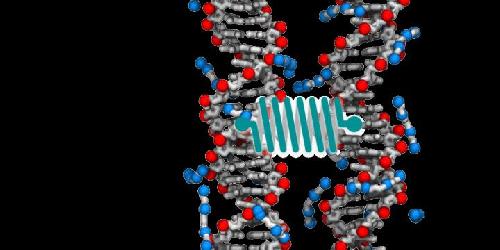CHAMPAIGN, Ill. -- Proteins play a large role in DNA regulation, but a new study finds that DNA molecules directly interact with one another in a way that's dependent on the sequence of the DNA and epigenetic factors. This could have implications for how DNA is organized in the cell and even how genes are regulated in different cell types, the researchers say.
Led by Aleksei Aksimentiev, a professor of physics at the University of Illinois, and Taekjip Ha, a professor of biophysics and biophysical chemistry at Johns Hopkins University and an adjunct at the University of Illinois Center for the Physics of Living Cells along with Aksimentiev, the researchers published their work in the journal Nature Communications.
"We are still only starting to explore the physical properties of DNA. It's not just a string of letters," Aksimentiev said. "It's a complex molecule with unique characteristics. The prevailing hypothesis is that everything that happens inside the nucleus, the way the DNA is organized, is all the work of proteins. What we show is that direct DNA-DNA interactions may play a role in large-scale chromosome organization as well."
 The researchers used atomic-level simulations to measure the forces between each atom. Credit: GIF courtesy of Alek Aksimentiev, University of Illinois
The researchers used atomic-level simulations to measure the forces between each atom. Credit: GIF courtesy of Alek Aksimentiev, University of Illinois
Using the Blue Waters supercomputer at the National Center for Supercomputing Applications on the Illinois campus, Aksimentiev and postdoctoral researcher Jejoong Yoo performed detailed simulations of two DNA molecules interacting in a charged solution such as is found in the cell. The supercomputer allowed them to map each individual atom and its behavior, and to measure the forces between the molecules. They found that, though DNA molecules tend to repel each other in water, in a cell-like environment two DNA molecules can interact according to their respective sequences.
"In the DNA alphabet, there is A, T, G and C. We found that when a sequence is rich in A and T, there is a stronger attraction," Aksimentiev said. "Then we looked at what actually causes it at the molecular level. We like to think of DNA as a nice symmetrical helix, but actually there's a line of bumps which are methyl groups, which we find are the key to regulating this sequence-dependent attraction."
One of the processes for regulating gene expression is methylation, which adds methyl groups to the DNA helix. In further simulations, the researchers found that the methyl groups strengthen the attraction, so sequences heavy in G and C with methyl groups attached will interact just as strongly as sequences rich in A and T.
"The key is the presence of charged particles in the solution," Aksimentiev said. "Let's say you have two people who don't like each other, but I like them both, so I can shake hands with both of them and bring them close. The counter-ions work exactly like that. The strength of how they pull the DNA molecules together depends on how many of them are between the molecules. When we have these bumps, we have a lot of counter-ions."
Ha and graduate researcher Hajin Kim experimentally verified the findings of the simulations. Using advanced single-molecule imaging techniques, they isolated two DNA molecules inside a tiny bubble, then watched to see how the molecules interacted. The experiments matched well with the data from the simulations, both for the sequence-dependent interactions and for interactions between methylated DNA.
"It was wonderful to see the computational predictions borne out exactly in our experiments," Ha said. "It tells us how accurate the atomic-level simulations are and shows that they can guide new research avenues."
The researchers posit that the observed interactions between DNA molecules could play a role in how chromosomes are organized in the cell and which ones are expanded or folded up compactly, determining functions of different cell types or regulating the cell cycle.
"For example, once you methylate DNA, the chromosome becomes more compact. It prevents the cellular machinery from accessing the DNA," Aksimentiev said. "It's a way to tell which genes are turned on and which are turned off. This could be part of the bigger question of how chromosomes are arranged and how organizational mechanisms can affect gene expression."
source: University of Illinois at Urbana-Champaign